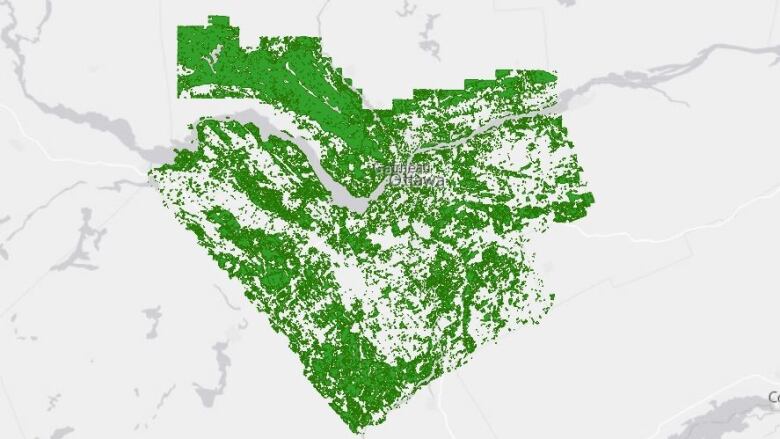Trees cover nearly half of our region, survey shows
Researchers used laser sensor technology to measure canopy

Nearly half of the National Capital Region is under the cover of trees, according to a new aerial survey of the area.
The survey, billed by the National Capital Commission as the first of its kind, was carried out in the fall of 2018 and winter of 2019by the University of Vermont in partnership withthe NCC and the cities of Ottawa and Gatineau.
Researchers used laser sensor technology to detect every tree at least two metres in height.
The survey showed that overall, 46 per cent of theregion is covered in trees. Seventy-six per cent ofNCC lands, including Gatineau Park, is under tree cover, while 45 per cent ofGatineau and just31 per cent of Ottawa is green.The figures for Ottawa and Gatineau exclude NCC lands.

Breaking it down
The least-treed wards in Ottawa areSomerset, where there's only 22 per cent tree cover, and Barrhaven with just 23 per cent, while Pointe-Gatineau has 24 per cent cover.
The most heavily treed ward isDeschnes, which includes parts of Aylmer, at 65 per cent. In fact, the eight greenest wards in the region are in Gatineau, the survey found. College ward is Ottawa's greenest, with 48 per cent.
Breaking it down further,Constance Bay's canopy covers 80 per cent of the west Ottawa community, while the Orlans Industrial Park off Innes Road has a meagre10per cent.
The report's authors found wealthier areas tend to have more trees, whileheavily populated areas tend to have fewer, though that's not a hard rule.

Plans for planting
Healthy trees reduce air and water pollution, control storm water and provide shade and habitats, along with improving the look of communities and adding a sense of place for its residents, according to the report.
"By truly understanding its health, the challenges it faces and how we can best protect it in the future, we will be able to improve our work with the cities and our other partners toward building a greener, more sustainable, more resilient capital region," said NCC CEO Tobi Nussbaumsaid in a news release.
The City of Ottawa has plans to plant half a million trees between 2018 and 2022, and Mayor Jim Watson said in the news release the maps will help determinewhere toplant them.
The report, which cost $31,000 and was split between the NCC and the twocities, recommends the tree canopy be measured every five to 10 years.












_(720p).jpg)


 OFFICIAL HD MUSIC VIDEO.jpg)
.jpg)



























































































